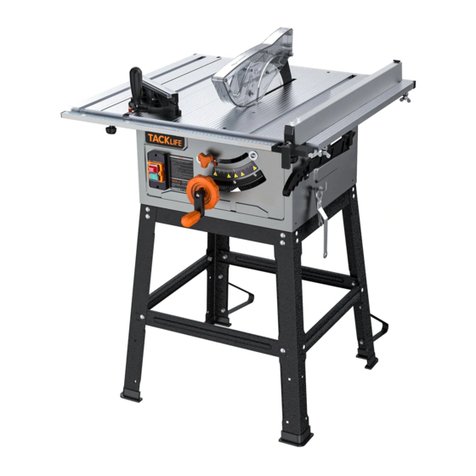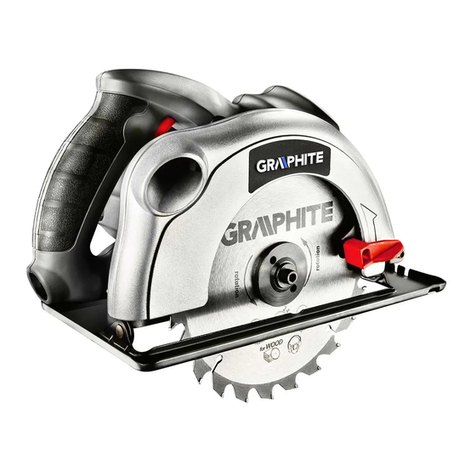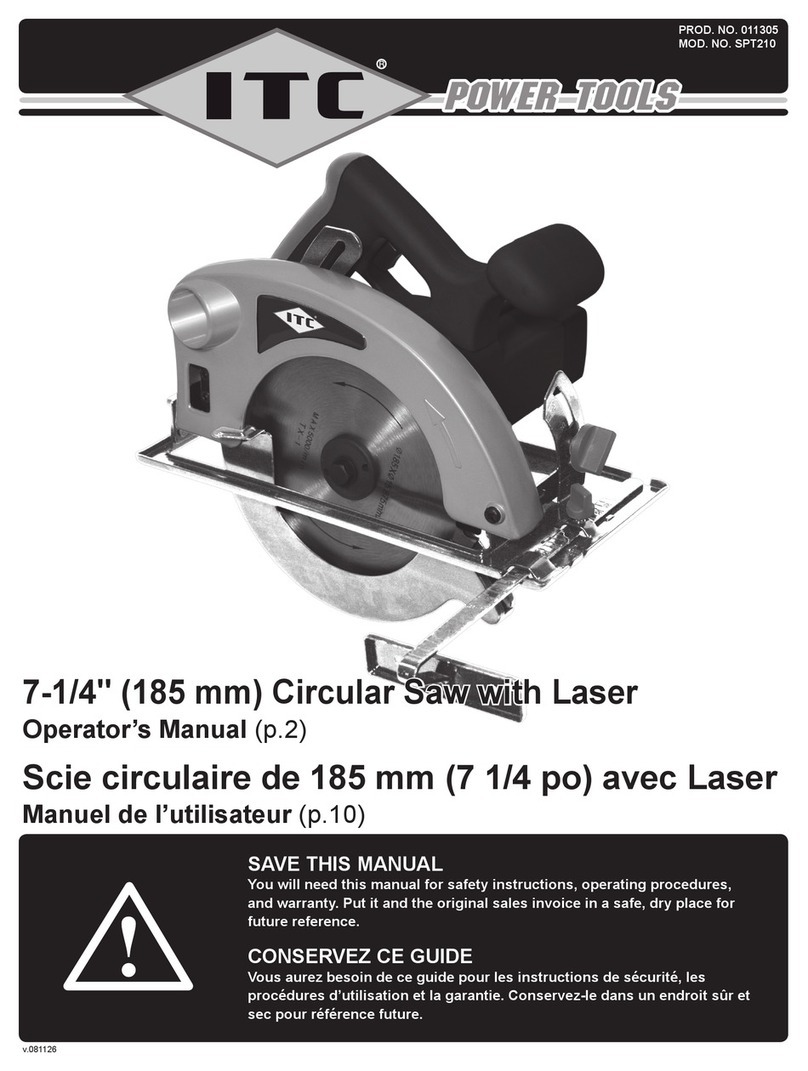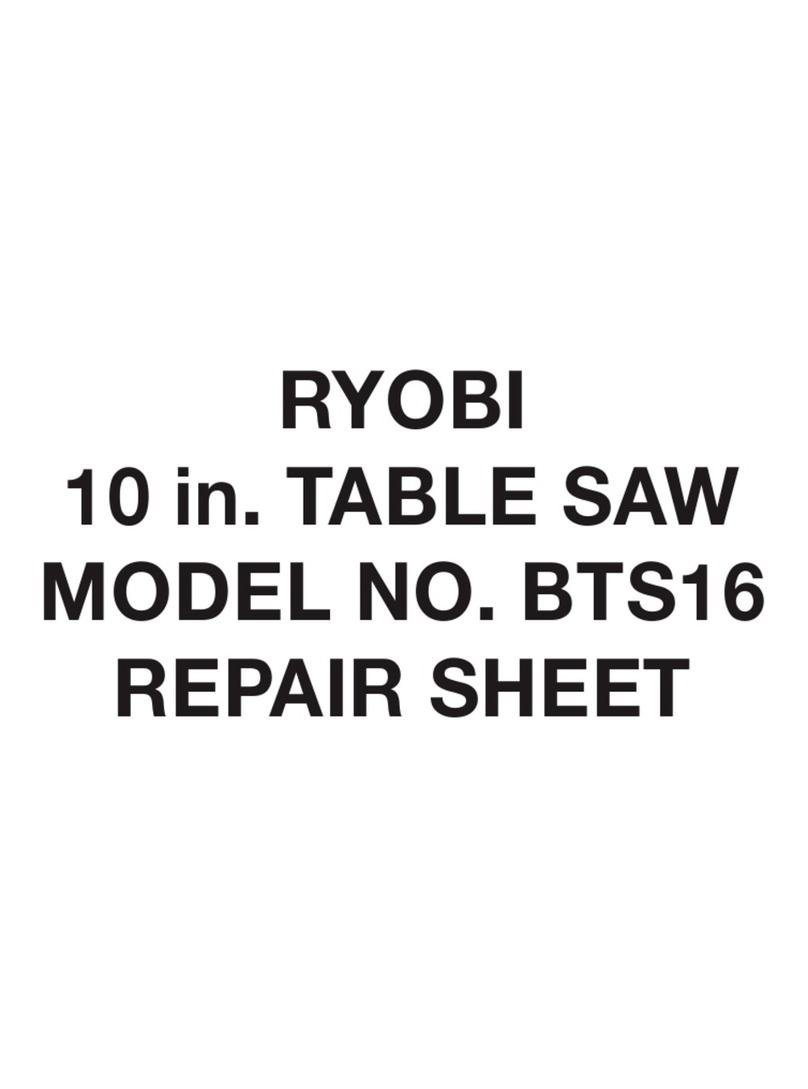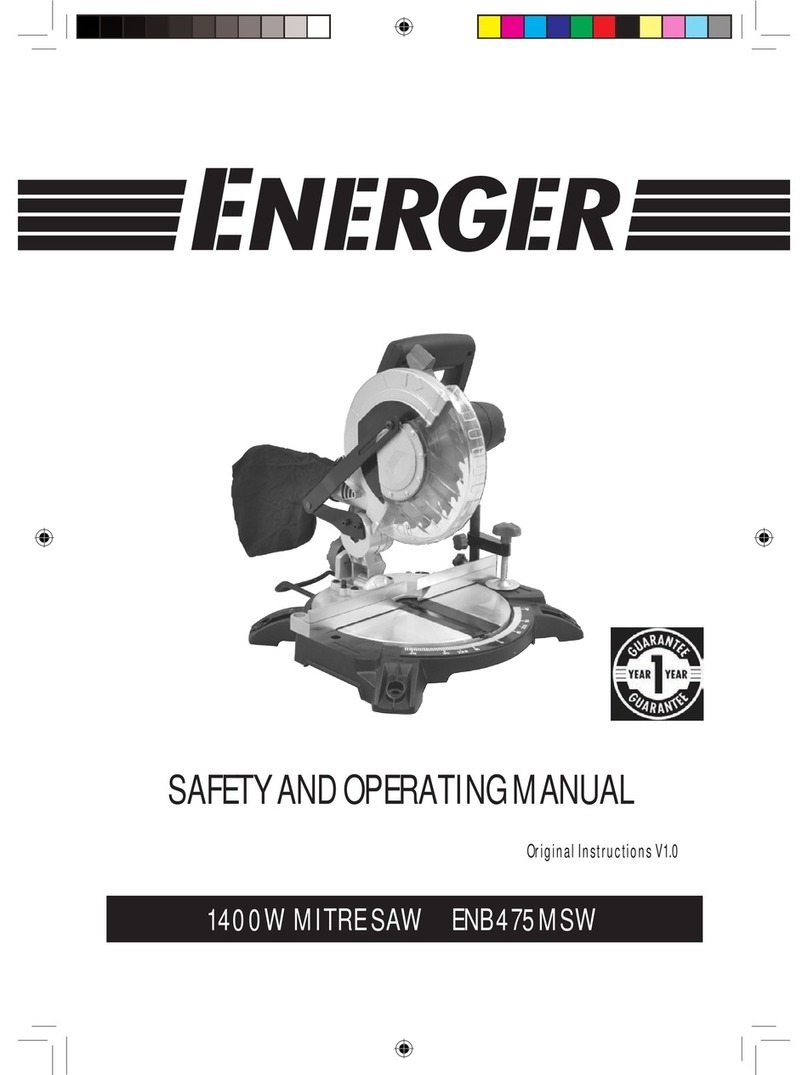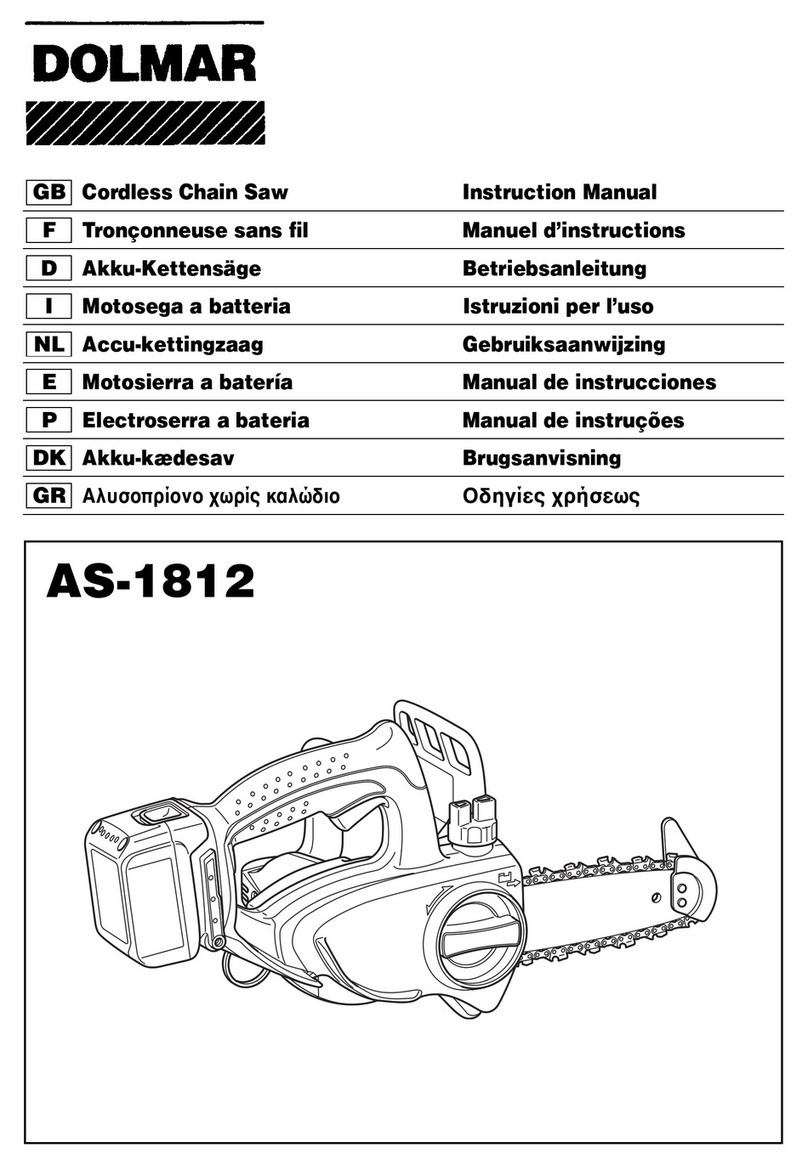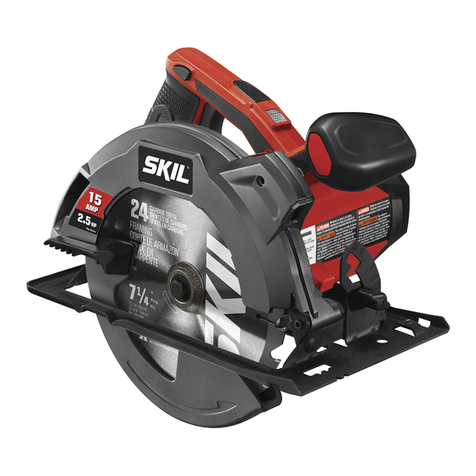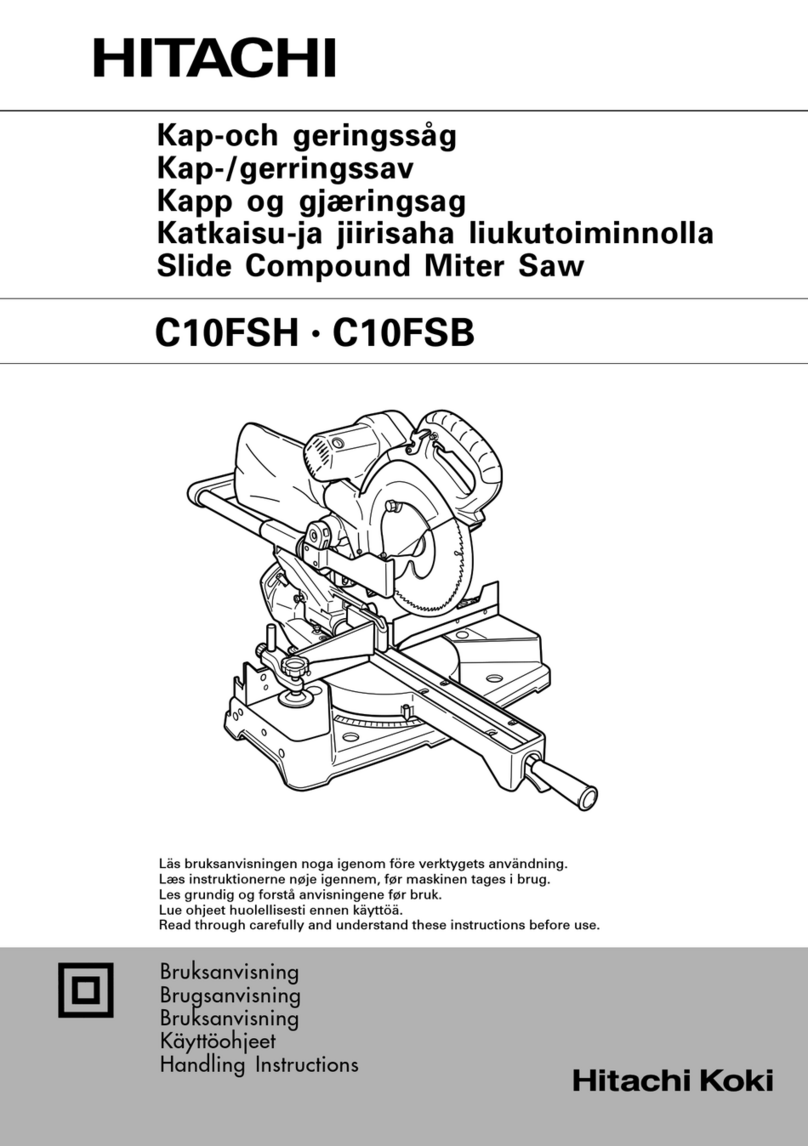Greatneck 80161 User manual

Owner’s Manual
High Speed Circular Saw
80161
CAUTION:
Before using this circular
saw or any of its
accessories, read this
manual and follow all
Safety Rules and
Operating Instructions.
• General Safety Rules
• Specific Safety Rules
and Symbols
• Functional Description
• Assembly
• Operation
• Maintenance
• Accessories

2
SECTION
PAGE
SECTION
PAGE
Warranty ….……………………….
2
Know your circular saw ……….
9
Product specifications …………...
2
Accessories ……………………
10
Power tool safety …………………
3–5
Carton contents……..………....
10
Specific safety rules ……………..
5–6
Assembly & operation ..………
11–14
Extension cord guidelines ..……..
7
Maintenance…….……………..
15
Symbols …………………………..
8
Parts listing ..……..………..
16–18
Distributed by GreatNeck Tools LLC, Mineola, NY 11501
Rev 1/11
WARRANTY
TABLE OF CONTENTS
SPECIFICATIONS
Rating ………………………
120 V 60 Hz AC
Amperes ……………………
11 A
Blade speed ……………….
5,400 RPM (no load)
Blade ……………………….
7-1/4" with 24 carbide teeth 5/8” arbor
Maximum cut depth @ 90°
2 1/2" (64 mm)
Maximum cut depth @ 45°
1 13/16” (46 mm)
Cutting angle ………………
0–45°
TOLL FREE HOTLINE 1-866-458-2472
ONE YEAR LIMITED WARRANTY
For one year from the date of purchase of this GreatNeck® product you
find any defect in material or workmanship, through normal usage,
either return it to the place of purchase, or send it to GreatNeck® Tools
LLC. for repair or replacement at our discretion. In order to obtain this
service send your tool and proof of purchase, transportation pre-paid, to
GreatNeck® Tools LLC Q.A. Dept, 3580 E. Raines Rd. #3,
Memphis, TN 38118. This warranty gives you specific legal rights, and
you may also have other rights, which vary from state to state.
This product is not guaranteed if used for industrial
or commercial purposes.

3
POWER TOOL SAFETY
WARNING: To avoid electrical hazards, fire hazards or damage to the circular
saw, use proper circuit protection.
The circular saw is wired at the factory for 110–120 V operation. It must be
connected to a 110–120 V, 15 A time delayed fuse or circuit breaker. To avoid shock
or fire, replace power cord immediately if it is worn, cut or damaged in any way.
!
!
ALWAYS WEAR EYE PROTECTION THAT CONFORMS WITH CSA
REQUIREMENTS or ANSI SAFETY STANDARD Z87.1
FLYING DEBRIS can cause permanent eye damage. Prescription
eyeglasses ARE NOT a replacement for proper eye protection.
WARNING: Non-compliant eyewear can cause serious injury if broken
during operation of a power tool.
SAVE THESE INSTRUCTIONS FOR REFERENCE
WARNING: Always wear a dust mask designed for use when
sawing.
!
WARNING: Some dust created by power sanding, sawing, grinding, drilling
and other construction activities contains chemicals known to cause cancer,
birth defects or other reproductive harm. Some examples of these chemicals are:
Lead from lead-based paints
Crystalline silica from bricks, cement and other masonry products
Arsenic and chromium from chemically-treated lumber
Your level of risk from these exposures varies, depending on how often you do
this type of work. To reduce your exposure to these chemicals, work in a well-
ventilated area and work with approved safety equipment such as dust masks
that are specially designed to filter out microscopic particles.
!

4
GENERAL SAFETY RULES
WARNING: Read and understand
all instructions. Failure to follow all
instructions listed below may result in
electric shock, fire and/or serious personal
injury.
WORK AREA
Keep your work area clean and well lit.
Cluttered benches and dark areas invite
accidents.
Do not operate power tools in explosive
atmospheres, such as in the presence of
flammable liquids, gas or dust. Power
tools create sparks which may ignite the
dust or fumes.
Keep bystanders, children and visitors
away while operating the tool.
Distractions can cause you to lose control.
ELECTRICAL SAFETY
Double insulated tools are equipped
with a polarized plug (one blade is wider
than the other). This plug will fit in a
polarized plug only one way. If the plug
does not fit fully in the outlet, reverse
the plug. If it still does not fit, contact a
qualified electrician to install a polarized
outlet. Do not change the plug in any
way. Double insulation eliminates the need
for the three-prong grounded power cord
and grounded power supply system.
Avoid body contact with grounded
surfaces such as pipes, radiators,
ranges and refrigerators. There is
increased risk of electric shock if your body
is grounded.
Do not expose power tools to rain or wet
conditions. Water entering the power tool
will increase the risk of electric shock.
Do not abuse the cord. Never use the
cord to carry the tools or pull the plug from
an outlet. Keep cord away from heat, oil,
sharp edges or moving parts. Replace
damaged cords immediately. Damaged
cords increase the risk of electric shock.
When operating a power tool outside,
use an outdoor extension cord marked
“W-A” or “W”. These cords are rated for
outdoor use and reduce the risk of electric
shock.
PERSONAL SAFETY
Stay alert, watch what you are doing and
use common sense when operating a
power tool. Do not use the tool while
tired or under the influence of drugs,
alcohol or medication. A moment of
inattention while operating power tools may
result in serious personal injury.
Dress properly. Do not wear loose
clothing or jewelry.
Contain long hair. Keep your hair,
clothing and gloves away from moving
parts. Loose clothing, jewelry or long hair
can be caught in moving parts.
Avoid accidental starting. Be sure
switch is OFF before plugging in.
Carrying tools with your finger on the switch
or plugging in tools that have the switch
turned ON invites accidents.
Remove adjusting keys or wrenches
before turning the tool ON. A wrench or
key that is left attached to a rotating part of
the tool may result in personal injury.
POWER TOOL SAFETY
SAVE THESE INSTRUCTIONS FOR REFERENCE
!

5
Do not overreach. Keep proper footing
and balance at all times. Proper footing
and balance enables better control of the
tool in unexpected situations.
Use safety equipment. Always wear eye
protection. Dust mask, non-skid safety
shoes, hard hat or hearing protection must
be used under applicable conditions.
TOOL USE AND CARE
Use clamps or other practical method to
secure and support the workpiece on a
stable platform. Holding the work by hand
or against your body is unsafe and may
lead to loss of control.
Do not force the tool. Use the correct
tool for your application. The correct tool
will do the job better and safer at the rate
for which it is designed.
Do not use the tool if the switch does
not turn it ON or OFF. Any tool that cannot
be controlled with the switch is dangerous
and must be repaired.
Disconnect the plug from the power
source before making any adjustments,
changing accessories or storing the
tool. Such preventive safety measures
reduce the risk of starting the tool
accidentally.
Store idle tools out of reach of children
and other untrained persons. Tools are
dangerous in the hands of untrained users.
Maintain tools with care. Keep cutting
tools sharp and clean. Properly
maintained cutting tools with sharp cutting
edges are less likely to bind and are easier
to control.
Check for misalignment or binding of
moving parts, breakage of parts and any
other condition that may affect the tool’s
operation. If damaged, have the tool
serviced before using. Many accidents
are caused by poorly maintained tools.
Use only accessories that are
recommended by the manufacturer for
your model. Accessories that may be
suitable for one tool may become
hazardous when used on another tool.
SERVICE
Tool service must be performed only by
qualified personnel. Service or
maintenance performed by unqualified
personnel could result in risk of injury.
When servicing a tool, use only identical
replacement parts. Follow instructions
in the Maintenance section of this
manual. Use of unauthorized parts or
failure to follow Maintenance instructions
may create a risk of electric shock or injury.
WARNING: For your safety, do not
plug in your circular saw until you have
carefully read and understood this
Owner’s Manual.
ALWAYS WEAR EYE PROTECTION
THAT CONFORMS WITH CSA
REQUIREMENTS or ANSI SAFETY
STANDARD Z87.1
FLYING DEBRIS can cause permanent eye
damage. Prescription
eyeglasses ARE NOT a
replacement for proper eye
protection.
POWER TOOL SAFETY
SAVE THESE INSTRUCTIONS FOR REFERENCE
!
SPECIFIC SAFETY RULES

6
WARNING: Non-compliant
eyewear can cause serious injury if
broken during operation of a power tool.
WARNING: Always use a dust
mask and hearing protection when
sawing.
Use only in well ventilated areas. Using
personal safety devices and working in a
safe environment reduces risk of injury.
Hold the tool by insulated gripping
surfaces when performing an operation
where the saw blade may contact hidden
wiring or its own cord. Contact with a “live”
wire will make exposed metal parts of the
tool “live” and shock the operator.
Always hold the tool with two hands.
Attempting to control the tool with only one
hand is dangerous. It could result in loss of
control and serious injury.
Always make sure the work surface is
free from nails and other foreign
objects. Cutting into a nail can cause the
blade and the tool to jump and damage the
blade.
Never hold the workpiece in one hand
and the tool in the other hand when
sawing. Never place your hands near or
below the cutting surface. Clamping the
material and guiding the tool with both
hands is much safer.
Always make sure the blade guard is
functioning properly. A broken guard may
cause serious injury.
Never lay workpiece on hard surfaces
like concrete, stone, etc. The protruding
blade may cause tool to jump.
DANGER: To avoid injury from
accidental starting, always remove the
plug from the power source before
making any adjustments and before
installing or removing a saw blade.
When replacing the blade, make sure the
replacement blade is 7¼" in diameter
and is rated for at least 7,000 RPM.
Installing an incorrect blade will result in
possible injury and poor cutting action.
After changing a blade or making
adjustments, make sure the blade clamp
screw is securely tightened. Loose
blades and adjustment devices will be
violently thrown.
Never use dull or damaged blades.
Sharp blades must be handled with care.
Damaged blades can snap during use. Dull
blades require more force to cut the
workpiece, possibly causing the blade to
break.
Never touch the blade during or
immediately after use. After use the blade
is too hot to be safely touched with bare
hands.
!
SAVE THESE INSTRUCTIONS FOR REFERENCE
SPECIFIC SAFETY RULES
!
!

7
Make sure your extension cord is the
proper size. When using an extension
cord, be sure to use one heavy enough to
carry the current the tool will draw.
An undersized cord will cause a drop in line
voltage resulting in loss of power and
overheating. The table below shows the
correct size to use according to cord length
and nameplate ampere rating. If in doubt,
use the next heavier gauge. The smaller
the gauge number the heavier the cord.
Be sure your extension cord is properly
wired and in good condition. Always
replace a damaged extension cord or have
it repaired by a qualified electrician before
using it. Protect your extension cord from
sharp objects, excessive heat and damp or
wet areas.
Use a separate electrical circuit for your
power tools. This circuit must not be less
than 14 gauge wire and should be
protected with either a 15A time delay fuse
or circuit breaker. Before connecting the
power tool to the power source, make sure
the switch is in the OFF position and the
power source is the same as indicated on
the nameplate. Running at lower voltage
will damage the motor.
WARNING: Repair or replace
damaged or worn extension cords
immediately.
Select the appropriate extension cord
gauge and length using the chart at right.
!
MINIMUM GAUGE (AWG) EXTENSION
CORDS (120 V use only)
Ampere rating
Total length in feet
More
than
Not
more
than
25’
50’
100’
150’
0
6
18
16
16
14
6
10
18
16
14
12
10
12
16
16
14
12
12
16
14
12
Not
Applicable
EXTENSION CORD GUIDELINES

8
This symbol designates that this tool is listed with Canadian/USA
requirements by ETL Testing Laboratories, Inc.
Conforms to UL STD. 60745-1, 60745-2-5
Certified to CAN/CSA STD. C22.2 No. 60745-1, 60745-2-5
V volts
A amperes
Hz hertz
W watt
kW kilowatts
microfarads
L litres
kg kilograms
H hours
N/cm2 newtons per square
centimetre
Pa pascals
Min minutes
S seconds
alternating current
three-phase alternating
current
three-phase alternating
current with neutral
direct current
no load speed
alternating or direct current
class II construction
splash proof construction
watertight construction
protective earthing at
earthing terminal, Class I
tools
revolutions or
reciprocations per minute
diameter
off position
arrow
warning symbol
WARNING: Some of the following symbols may be used on your
tool. Please study them and learn their meaning. Proper interpretation
of these symbols will allow you to operate the tool better and safer.
!
SYMBOLS
USC
HOMOLOGUÉ
Intertek
3042597
JD3589U

9
KNOW YOUR CIRCULAR SAW
Lock-off
button
Cutting depth
locking lever
Blade screw
hex key
Bevel
gauge
Bevel gauge
locking knob
Blade
guard
Trigger
switch
Sole plate
Main
handle
Front
handle
Dust port
Blade guard
lever
0° Cutting
mark
45° Cutting
mark

10
AVAILABLE ACCESSORIES
WARNING: Use only saw blades
recommended for this circular saw.
Follow instructions that accompany the
saw blade. Improper use of saw blades
may cause injury to the operator or
damage to the circular saw.
Do not use any accessory unless you have
completely read the instructions or Owner’s
Manual for that accessory.
Circular saw blades
WARNING: If any part is missing or
damaged, do not plug the tool into the
power source until the missing or
damaged part is replaced.
CARTON CONTENTS
Carefully unpack the circular saw. Compare
against the “Circular Saw Components”
chart below.
NOTE: See illustration of components
below.
WARNING: To avoid fire or toxic
reaction, never use gasoline, naphtha,
acetone, lacquer thinner or similar
highly volatile solvents to clean the tool.
!
!
!
CIRCULAR SAW COMPONENTS
KEY
DESCRIPTION
QTY
A
Saw assembly
1
B
5 mm Hex key
1
C
Blade 7-1/4"
24-tooth 5/8” arbor
1
Owner’s manual
1
ACCESSORIES & CARTON CONTENTS
CARTON CONTENTS
A
B
C

11
CHANGING THE BLADE
WARNING: Always remove the
plug from the power source before
removing the blade or adjusting the saw
in any way.
1. Press inward on the shaft locking
button (1) (Fig. 1).
2. Insert 5 mm hex key into the blade
screw (2) (Fig. 2). While pressing in the
shaft locking button (Fig. 1), rotate the
hex key counter clockwise until the
shaft locking button engages the blade
shaft. Continue turning the hex key
counter clockwise to remove the blade
screw, lock washer (3), flat washer (4)
and large outer flange washer (5).
3. Open the blade guard by lifting upward
on the blade guard lever (6) (Fig. 3).
Rotate the blade guard in a clockwise
direction to expose the blade (7).
4. While holding the blade guard lever in
the open position, lift the blade (7) off
the shaft (8) and slide it out through the
slot in the sole plate (9) (Fig. 4).
NOTE: Do NOT remove the inner large
flange washer.
WARNING: Use caution when
handling the blade. It is sharp and can
easily cut your hand.
5. To place a new blade onto the motor
shaft, rotate the blade guard forward
(Fig.3) and slide the blade through the
slot in the sole plate until it fits over the
motor shaft (Fig. 4).
NOTES:
a) Make sure the blade teeth are
pointing forward at the bottom of the
blade.
b) Make sure the hole in the blade is
placed over the matching boss on the
inner large flange washer.
ASSEMBLY AND OPERATION
!
Fig. 1
Fig. 4
!
Fig. 2
Fig. 3
6
4
5
0
°
°

12
CHANGING THE BLADE – cont’d
6. Place the large outer flat washer onto
the motor shaft.
NOTE: Make sure the flat sections of
the large outer flange washer fit over
the matching flat sections on the motor
shaft.
7. Insert the blade screw through the lock
washer, flat washer and the large outer
flange washer and thread it clockwise
into the end of the motor shaft.
8. Lock the motor shaft using the shaft
locking button and firmly tighten the
blade screw using the hex key.
NOTE: Make sure the screw is NOT
cross-threaded and that the blade
does not wobble when turned by hand.
SETTING THE CUTTING DEPTH
The cutting depth of the blade should be
set to suit the thickness of the material
being cut. The cutting depth should be
approximately 1/8" (3 mm) greater than the
thickness of the material being cut.
1. Loosen the depth adjustment lever (1)
by pulling it outward (Fig. 5).
2. Pull the sole plate (2) downward until
the correct amount of the blade is
protruding below the sole plate.
3. Push down firmly on the depth
adjustment lever to lock the sole plate
in position.
BEVEL CUTTING
The sole plate can be tilted to provide bevel
cuts from 0–45°.
1. Loosen the bevel gauge adjustment
knob (1) by turning it counter-
clockwise (Fig. 6).
2. Rotate the sole plate (2) to the desired
angle as shown on the gauge (3), and
the alignment mark.
3. Tighten the bevel gauge adjustment
knob to lock the sole plate in position.
4. Make a test cut on a scrap piece of the
workpiece to verify that the cutting
angle is set properly.
5. Adjust cutting angle as necessary.
Fig. 5
ASSEMBLY AND OPERATION
Fig. 6

13
LOCK-OFF BUTTON
The lock-off button (1) is a safety device
designed to reduce the possibility of
accidentally starting the saw (Fig. 7). This
button must be depressed before the
trigger switch (2) can be depressed.
TRIGGER SWITCH
1. To turn the saw ON, depress the lock-
off button with your right thumb.
2. While holding the lock-off button in the
depressed position, squeeze the
trigger switch to start the saw.
3. Once the saw starts, release the lock-
off button. The saw will remain running
until the trigger switch is released.
4. To turn the saw OFF, release the
trigger switch.
NOTE: To re-start the saw, the lock-off
button must be depressed again
before the trigger switch is squeezed.
ASSEMBLY AND OPERATION
WARNING: Have you read
“POWER TOOL SAFETY”,
“SPECIFIC SAFETY RULES”,
“EXTENSION CORD GUIDELINES”
and “SYMBOLS” on pages 3, 4, 5,
6, 7, & 8 of this Manual? If not,
please do it now before you operate
this circular saw. Your safety
depends on it!
Every time you use the circular saw
you should verify the following:
Blade is tight and sharp.
All adjustments are tight.
Workpiece is properly secured.
Safety glasses are being worn.
Failure to adhere to these safety
rules can greatly increase the
chances of injury.
!
Fig. 7

14
MATERIALS YOU CAN CUT
The circular saw is a versatile saw that
allows you to cut many different types of
materials. Some of the materials include:
• Wood products such as lumber,
hardwood, plywood, composition
board and panelling
• Drywall
• Masonite and plastic
NOTE: There are several different types of
blades available. Generally, blades with
carbide-tipped teeth cut better and stay
sharp longer. Tooth count and configuration
are also important. High tooth counts cut
slower and are best suited for making
smooth cuts on thinner materials such as
panelling. Use the correct blade for your
application.
GENERAL CUTTING
1. Make any adjustments to the saw
before plugging it into the power
source. Adjustments include cutting
depth, bevel cutting angle and rip
guide (if installed).
2. Clearly mark the workpiece to locate
the position of the cut.
3. Hold smaller workpiece with a vise.
Clamp larger workpiece to a work
bench or table.
DANGER: Any workpiece that is
not adequately clamped in place may
come loose and cause serious injury.
Never hold the workpiece in your hand.
4. Make sure there are no nails, screws,
clamps or foreign materials in the path
of the saw blade.
5. With both hands firmly gripping the
saw, and the blade NOT in contact with
the surface to be cut, start the saw by
depressing the lock-off button and then
the trigger switch.
6. Once the saw has reached full speed,
place the front edge of the sole plate
on the workpiece and gradually bring
the moving blade into contact with the
workpiece at the appropriate location.
NOTE: To align the saw blade with the
cutting mark, use the guide marks on the
front of the sole plate (Fig. 8). Use the 0°
line (1) for right angle cuts. Use the 45°
mark (2) for 45° bevel cuts. This will allow
for the extra material needed for the angle
cut. Always make a test cut on a scrap
workpiece before cutting the new material.
WARNING: Do not force the
circular saw. Use only enough force to
keep the blade cutting at full speed.
Excessive pressure on the blade will
cause it to slow down and overheat,
resulting in poor cut quality and damage
to the motor.
!
!
ASSEMBLY AND OPERATION
Fig. 8

15
WARNING: When servicing, use
only Great Neck replacement parts. Use
of any other part may create a hazard or
cause product damage.
DO NOT abuse power tools. Abusive
practices can damage the tool as well as
the workpiece.
WARNING: DO NOT attempt to
modify tools or create accessories. Any
such alteration or modification is
misuse and could result in a hazardous
condition leading to possible serious
injury. It will also void the warranty.
CLEANING
DO NOT use solvents when cleaning
plastic parts. Most plastics are susceptible
to damage from various types of
commercial solvents and may be damaged
by their use. Use a clean cloth to remove
dirt, dust, oil, grease, etc.
WARNING: Do not at any time
allow brake fluids, gasoline, petroleum-
based products, penetrating oils, etc. to
come in contact with plastic parts. They
contain chemicals that can damage,
weaken or destroy plastic.
It has been found that electric tools are
subjected to accelerated wear and possible
premature failure when they are used on
fiberglass boats and sports cars, wallboard,
spackling compounds or plaster. The chips
and grindings from these materials are
highly abrasive to electric tool parts such as
bearings, brushes, commutators, etc.
Consequently, it is not recommended that
this tool be used for extended work on any
fiberglass material, wallboard, spackling
compounds or plaster. During any use on
these materials it is extremely important
that the tool is cleaned frequently by
blowing out with an air jet.
WARNING: Always wear safety
goggles or safety glasses with side
shields during all sawing operations. It
is critical that you also wear safety
goggles or safety glasses with side
shields and a dust mask while blowing
dust out of the circular saw with an air
jet. Failure to take these safety
precautions could result in permanent
eye or lung damage.
LUBRICATION
All of the bearings in this circular saw are
lubricated with a sufficient amount of high-
grade lubricant for the life of the unit under
normal conditions. Therefore, no further
lubrication is required.
!
!
!
!
MAINTENANCE

16
PARTS DIAGRAM – MODEL 80161

WARNING: When servicing, use only GreatNeck replacement parts. Use of any
other parts may create a HAZARD or cause damage to your power tool.
Any attempt to repair or replace electrical parts on this power tool may create a
hazard unless repair is performed by a qualified technician.
Always order by PART NUMBER, not by key number.
Key #
Part #
Part Name
Quantity
1
80161-1
Tapping screw ST3.9x14
4
2
80161-2
Tapping screw ST3.9x9
2
3
80161-3
Motor cover
1
4
80161-4
Screw M5x60
2
5
80161-5
Screw M5x52
1
6
80161-6
Spring washer 5
3
7
80161-7
Brush cover
2
8
80161-8
Carbon brush
2
9
80161-9
Brush holder
2
10
80161-10
Brush holder support
2
11
80161-11
Housing
1
12
80161-12
Stator
1
13
80161-13
Air baffle ring
1
14
80161-14
Tapping screw ST3.9x70
2
15
80161-15
Bearing sleeve
1
16
80161-16
Bearing 607-2RS
1
17
80161-17
Rotor
1
18
80161-18
Blocking plate
1
19
80161-19
Spring
1
20
80161-20
Bearing 6000-2z
1
21
80161-21
Tapping screw ST3.9x19
7
22
80161-22
Left handle
1
23
80161-23
Switch
1
24
80161-24
Right handle
1
25
80161-25
Screw M4x12
3
26
80161-26
Spring washer
3
27
80161-27
Retaining ring
1
28
80161-28
Depth lock knob
1
29
80161-29
Thickened washer 6
2
30
80161-30
Depth lock lever
1
(Continued on pg.18)
!
PARTS LIST – MODEL 80161
17

Key #
Part #
Part Name
Quantity
31
80161-31
Gear housing
1
32
80161-32
Square neck bolt M6x16
1
33
80161-33
Rubber buffer
1
34
80161-34
Hex screw M6x16
1
35
80161-35
Needle bearing HK0810
1
36
80161-36
Retaining ring
1
37
80161-37
Wave washer
1
38
80161-38
Big gear
1
39
80161-39
Output shaft
1
40
80161-40
Flat key
1
41
80161-41
Bearing 6001-2RS
1
42
80161-42
Gear housing cover
1
43
80161-43
Countersink screw M5x12
3
44
80161-44
Torsion spring
1
45
80161-45
Moveable guard
1
46
80161-46
Moveable guard lever
1
47
80161-47
Screw M5x14
1
48
80161-48
Retaining ring
1
49
80161-49
Inner flange
1
50
80161-50
Blade
1
51
80161-51
Outer flange
1
52
80161-52
Wave washer
1
53
80161-53
Hex screw M6x20
1
54
80161-54
Fixed guard
1
55
80161-55
Dust exit
1
56
80161-56
Part A of hex key holder
1
57
80161-57
Part B of hex key holder
1
58
80161-58
Tapping screw ST2.9x6
2
59
80161-59
Cord clamp
1
60
80161-60
Cord guard
1
61
80161-61
Cord set
1
62
80161-62
Hex key
1
63
80161-63
Base plate
1
64
80161-64
Hex lock nut
1
65
80161-65
Square neck bolt
1
66
80161-66
Flat washer
1
67
80161-67
Bevel adjustment & lock knob
1
68
80161-68
Spring
1
69
80161-69
M5x41 special screw
1
PARTS LIST – MODEL 80161 (Cont’d)
18
Customer Service: 1-866-458-2472
www.greatnecktools.com
ALWAYS WEAR SAFETY GOGGLES
GREATNECK TOOLS, LLC
MINEOLA, NY 11501
MADE IN CHINA
Table of contents
Other Greatneck Saw manuals
Popular Saw manuals by other brands

Husqvarna
Husqvarna SOFF-CUT 150 Operator's manual

Central Machinery
Central Machinery 41889 Assembly & operating instructions

Diamondback
Diamondback 64684 Owner's manual & safety instructions

EINHELL
EINHELL TC-MS 2513 T Original operating instructions

EINHELL
EINHELL TE-TS 36/210 Li-Solo Original operating instructions

FOM INDUSTRIE
FOM INDUSTRIE SIKA PLUS Use and maintenance manual

